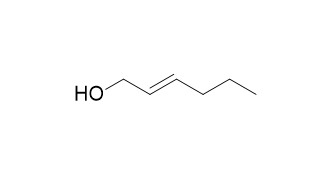trans-2-Hexen-1-ol
trans-2-Hexen-1-ol could be attractants for Asias halodendri adults.
Inquire / Order:
manager@chemfaces.com
Technical Inquiries:
service@chemfaces.com
Tel:
+86-27-84237783
Fax:
+86-27-84254680
Address:
1 Building, No. 83, CheCheng Rd., Wuhan Economic and Technological Development Zone, Wuhan, Hubei 430056, PRC
Providing storage is as stated on the product vial and the vial is kept tightly sealed, the product can be stored for up to
24 months(2-8C).
Wherever possible, you should prepare and use solutions on the same day. However, if you need to make up stock solutions in advance, we recommend that you store the solution as aliquots in tightly sealed vials at -20C. Generally, these will be useable for up to two weeks. Before use, and prior to opening the vial we recommend that you allow your product to equilibrate to room temperature for at least 1 hour.
Need more advice on solubility, usage and handling? Please email to: service@chemfaces.com
The packaging of the product may have turned upside down during transportation, resulting in the natural compounds adhering to the neck or cap of the vial. take the vial out of its packaging and gently shake to let the compounds fall to the bottom of the vial. for liquid products, centrifuge at 200-500 RPM to gather the liquid at the bottom of the vial. try to avoid loss or contamination during handling.
Biomed Sci Letters.2020, 26:319-326
Nat Prod Sci.2018, 24(3):206
Histol Histopathol.2022, 18518.
Carbohydrate Polymer Technologies & App.2021, 2:100049.
Analytical sci. & Tech2016, 186-193
Microchemical Journal2024: 196:109676.
Environ Toxicol.2023, 23929.
Molecules.2019, 24(11):E2102
Food Science and Preservation2024, 31(3):486-498.
Pharmaceuticals (Basel).2024, 17(9):1130.
Related and Featured Products
Brain Research, 1988, 447(1):0-17.
Integration of olfactory information in the Colorado potato beetle brain.[Reference:
WebLink]
The processing of olfactory information in the Colorado potato beetle, Leptinotarsa decemlineata Say, was studied by recording responses of olfactory neurones intracellularly in the deutocerebrum.
METHODS AND RESULTS:
Response characteristics of neurones in this first relay station of the olfactory pathway were measured when the antennae were stimulated with five general green leaf volatiles, i.e. cis-3-hexen-1-ol, trans-2-hexenal, cis-3-hexenyl acetate, trans-2-Hexen-1-ol and 1-hexanol. These compounds are part of the so-called green odour of potato, whose defined composition is essential for the beetle's host plant finding. The response spectra of deutocerebral neurones can be divided roughly into two classes: one class containing neurones which are not very specific for the tested compounds, and another class with highly specialized neurones.
CONCLUSIONS:
Their different responses to a potato leaf extract suggest two channels for the processing of olfactory information in the antennal lobe: one channel for the detection of the presence of green leaf odour components, and another one for an evaluation of the component ratios.
Journal of tianjin normal university, 2017.
EAG and behavioral responses of Asias halodendri to the volatiles of Vitis vinifera。[Reference:
WebLink]
To develop the attractant with highly attractive activity to Asias halodendri adults,six volatiles of its host-plant Vitis vinifera were selected,i.e. 1-penten-3-ol,methyl linoleate,4-methyl-1-pentanol,trans-2-Hexen-1-ol,ocimene and ethyl acetate.
METHODS AND RESULTS:
The former five kinds of compounds were adopted as single attractant,and were composed with ethyl acetate to make fourteen kinds of multicomponent formula with different component and proportion. In order to test the effect of these attractants on the adults of Asias halodendri,electroantennogram(EAG)and behavioral response experiments were employed on them. The results showed that,as for the EAG tests of female adults,only the single component 1-penten-3-ol showed higher attractive activity,and the difference compared with the control had statistic significance(P 0.05). In the behavioral response of female adults,the formula P1,P2,P3,P8 and trans-2-Hexen-1-ol showed highly attractive activity.As for the EAG response of male adults,methyl linoleate,4-methyl-1-pentanol,1-penten-3-ol and P1 had attractive activity,but only the difference of methyl linoleate and 4-methyl-1-pentano compared with the control had statistic significance(P 0.05). In the tests of behavioral response of male adults,ocimene,4-methyl-1-pentanol,P1,P2 and P3 all had attractive activity,among which ocimene had the largest activity.
CONCLUSIONS:
Overall,as for the female adults of Asias halodendri,the multicomponent formulas had higher attractive activity,and as for the male adults,the single component had higher attrac-tive activity.
Pakistan journal of pharmaceutical ences, 2016, 29(5):1591-1600.
GC-MS analyses of the volatiles of Houttuynia cordata Thunb[Reference:
WebLink]
GC-MS is the basis of analysis of plant volatiles. Several protocols employed for the assay have resulted in inconsistent results in the literature.
METHODS AND RESULTS:
We developed a GC-MS method, which were applied to analyze 25 volatiles (α- pinene, camphene, ß-pinene, 2-methyl-2-pentenal, myrcene, (+)-limonene, eucalyptol, trans-2-hexenal, γ-terpinene, cis- 3-hexeneyl-acetate, 1-hexanol, α-pinene oxide, cis-3-hexen-1-ol, trans-2-Hexen-1-ol, decanal, linalool, acetyl-borneol, ß- caryophyllene, 2-undecanone, 4-terpineol, borneol, decanol, eugenol, isophytol and phytol) of Houttuynia cordata Thunb. Linear behaviors for all analytes were observed with a linear regression relationship (r2>0.9991) at the concentrations tested. Recoveries of the 25 analytes were 98.56-103.77% with RSDs <3.0%. Solution extraction (SE), which involved addition of an internal standard, could avoid errors for factors in sample preparation by steam distillation (SD) and solidphase micro extraction (SPME). Less sample material (0.05g fresh leaves of H. cordata) could be used to determine the contents of 25 analytes by our proposed method and, after collection, did not affect the normal physiological activity or growth of H. cordata.
CONCLUSIONS:
This method can be used to monitor the metabolic accumulation of H. cordata volatiles.



